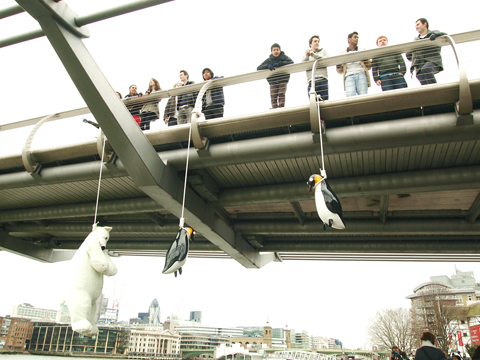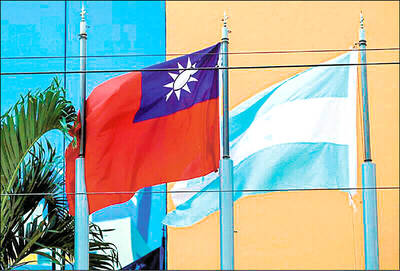“The fate of my country rests in your hands,” said Ian Fry, the Tuvaluan delegate to the UN Climate Change Conference in Copenhagen last year.
TV images of him tearfully pleading for legally binding agreements to fight climate change shocked Taiwanese artist Vincent Huang (黃瑞芳).
Huang, 39, decided to try to help raise awareness of the small Pacific country of Tuvalu, which faces rising sea levels that threaten to make it one of the first victims of global warming.

PHOTO: CNA
On July 17 on Funafuti, Tuvalu’s main island, Huang and two assistants waded out to a reef to erect a small sculpture of a desiccated mermaid made of dried coconut shells and scraggly pieces of palm trees. Later, children swam around the artwork wearing fake shark fins.
“The installation art of the dried Little Mermaid represented the failure of the Copenhagen climate summit. It is surrounded by sharks, a metaphor for the big powers,” Huang told the Central News Agency in Taipei, adding that waves battered the artwork, causing its partial destruction.
After displaying the work for about an hour, Huang burned the piece — titled Den lille havfrue after the Little Mermaid statue in the Danish capital — and collected the ashes in preparation for the next phase of his project.
“I will take ashes to England, the place where the Industrial Revolution began,” he said.
While the eco-art project may have been the first of its kind in Tuvalu, taking on serious issues is not new to Huang.
“An artist can also do something for the world; I learned this while pursuing my master’s degree at Robert Gordon University in Aberdeen, Scotland, 10 years ago,” he said.
Huang has gained international attention with works like his sculpture of a polar bear holding US President Barack Obama’s severed head in its mouth, and his Suicide Penguins series that features penguins hanging from nooses in public places ranging from Taipei to London.
Polar bears and penguins are a recurring theme in Huang’s work — like Tuvaluans, their homes are in danger.
Climate change is not exclusive to any one nation or living creature, Huang said. It does not discriminate.
“Tuvalu will encounter the problem first, which is not fair, since it is a non-industrialized nation where people live a simple life, but have to pay for the failed policies of other countries,” he said.
Huang’s next plan for the Polynesian island is titled Balefire Project in Tuvalu, in which he plans to use an ancient Chinese practice to spread his message.
Huang said he would burn dried coconut shells along the coast of Funafuti during the day, creating old-fashioned distress signals. A more modern version will continue at night, when he plans to aim about 50 green laser lights into the sky from several locations around the island.
The artist said he is planning the project for the end of this month, but his work will not stop there.
“After finishing this piece, I will continue with another project during the Mexico climate change summit to be held at the end of November,” he said.
“I plan to draw the attention of the world to the problem of this island [Tuvalu] and enable people to work together to protect the Earth, which is home to all of us,” he said.

Chinese Nationalist Party (KMT) Chairman Eric Chu (朱立倫), spokeswoman Yang Chih-yu (楊智伃) and Legislator Hsieh Lung-chieh (謝龍介) would be summoned by police for questioning for leading an illegal assembly on Thursday evening last week, Minister of the Interior Liu Shyh-fang (劉世芳) said today. The three KMT officials led an assembly outside the Taipei City Prosecutors’ Office, a restricted area where public assembly is not allowed, protesting the questioning of several KMT staff and searches of KMT headquarters and offices in a recall petition forgery case. Chu, Yang and Hsieh are all suspected of contravening the Assembly and Parade Act (集會遊行法) by holding

PRAISE: Japanese visitor Takashi Kubota said the Taiwanese temple architecture images showcased in the AI Art Gallery were the most impressive displays he saw Taiwan does not have an official pavilion at the World Expo in Osaka, Japan, because of its diplomatic predicament, but the government-backed Tech World pavilion is drawing interest with its unique recreations of works by Taiwanese artists. The pavilion features an artificial intelligence (AI)-based art gallery showcasing works of famous Taiwanese artists from the Japanese colonial period using innovative technologies. Among its main simulated displays are Eastern gouache paintings by Chen Chin (陳進), Lin Yu-shan (林玉山) and Kuo Hsueh-hu (郭雪湖), who were the three young Taiwanese painters selected for the East Asian Painting exhibition in 1927. Gouache is a water-based

Taiwan would welcome the return of Honduras as a diplomatic ally if its next president decides to make such a move, Minister of Foreign Affairs Lin Chia-lung (林佳龍) said yesterday. “Of course, we would welcome Honduras if they want to restore diplomatic ties with Taiwan after their elections,” Lin said at a meeting of the legislature’s Foreign Affairs and National Defense Committee, when asked to comment on statements made by two of the three Honduran presidential candidates during the presidential campaign in the Central American country. Taiwan is paying close attention to the region as a whole in the wake of a

OFF-TARGET: More than 30,000 participants were expected to take part in the Games next month, but only 6,550 foreign and 19,400 Taiwanese athletes have registered Taipei city councilors yesterday blasted the organizers of next month’s World Masters Games over sudden timetable and venue changes, which they said have caused thousands of participants to back out of the international sporting event, among other organizational issues. They also cited visa delays and political interference by China as reasons many foreign athletes are requesting refunds for the event, to be held from May 17 to 30. Jointly organized by the Taipei and New Taipei City governments, the games have been rocked by numerous controversies since preparations began in 2020. Taipei City Councilor Lin Yen-feng (林延鳳) said yesterday that new measures by